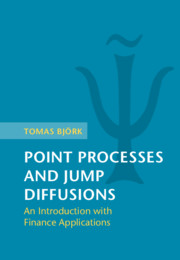Book contents
- Frontmatter
- Contents
- Preface
- Part I Point Processes
- Part II Optimal Control in Discrete Time
- Part III Optimal Control in Continuous Time
- Part IV Non-Linear Filtering Theory
- Part V Applications in Financial Economics
- 16 Basic Arbitrage Theory
- 17 Poisson-Driven Stock Prices
- 18 The Simplest Jump-Diffusion Model
- 19 A General Jump-Diffusion Model
- 20 The Merton Model
- 21 Determining a Unique Q
- 22 Good-Deal Bounds
- 23 Diversifiable Risk
- 24 Credit Risk and Cox Processes
- 25 Interest-Rate Theory
- 26 Equilibrium Theory
- References
- Index of Symbols
- Subject Index
26 - Equilibrium Theory
from Part V - Applications in Financial Economics
Published online by Cambridge University Press: 27 May 2021
- Frontmatter
- Contents
- Preface
- Part I Point Processes
- Part II Optimal Control in Discrete Time
- Part III Optimal Control in Continuous Time
- Part IV Non-Linear Filtering Theory
- Part V Applications in Financial Economics
- 16 Basic Arbitrage Theory
- 17 Poisson-Driven Stock Prices
- 18 The Simplest Jump-Diffusion Model
- 19 A General Jump-Diffusion Model
- 20 The Merton Model
- 21 Determining a Unique Q
- 22 Good-Deal Bounds
- 23 Diversifiable Risk
- 24 Credit Risk and Cox Processes
- 25 Interest-Rate Theory
- 26 Equilibrium Theory
- References
- Index of Symbols
- Subject Index
Summary
In this chapter we study dynamic market equilibrium. This is done within the framework of a representative agent and a unit net supply jump–diffusion endowment process. We derive formulas for the equilibrium short, the equilibrium stochastic discount factor, and the equilibrium market prices of risk. We also study factor models and give concrete examples. We finish by studying an equilibrium model with partial observations, using our earlier filtering results.
Keywords
- Type
- Chapter
- Information
- Point Processes and Jump DiffusionsAn Introduction with Finance Applications, pp. 284 - 297Publisher: Cambridge University PressPrint publication year: 2021

